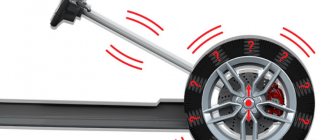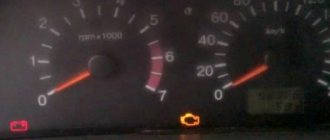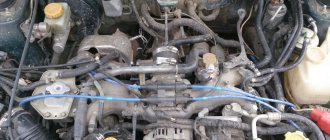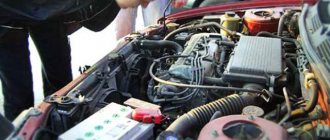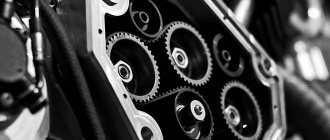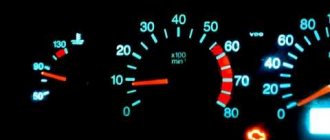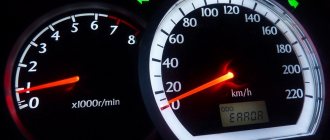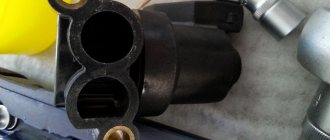During the service life, various emergency situations may arise. It's good when the problem is obvious. But it happens when one or another symptom may indicate several problems at once. Such manifestations on Ford Focus 1 include a stalling engine, for example, at idle, when moving slowly or braking. Naturally, this is a problem not only with the Focus, but with any car.
By collecting and analyzing the many years of experience of FordFocus owners, we can identify a number of problems that such a symptom may indicate. Usually it manifests itself in conjunction with the fact that the car does not start, power is lost, etc.
The cause of a stalled engine is the spark plugs
In 50% of cases, the problem is due to the fact that the spark plugs simply do not produce a spark. This failure occurs as a result of 3 reasons:
- contacts become clogged;
- plaque forms along the entire contour of the candle;
- malfunction when supplying voltage to the spark plug.
However, the most popular is still black carbon deposits on the spark plugs, which prevents the spark from appearing or causes it to work periodically.
Tip: if the spark plug set malfunctions, you will hear a “triple” sound that is uncharacteristic of the engine. In this case, the car will jerk strongly while moving. As a result, the engine will either stall on its own, or you will need to turn it off and turn the ignition on again.
If you see dirt on the surface of the contacts, this indicates the need to replace a low-quality type of fuel or check the serviceability of the oil supply systems. It is the oil supply adjustment sensors that can splash the spark plugs with it if there is a problem. Also, oil that appears on a set of spark plugs may indicate serious damage to components in the engine cylinders. Be sure to check the engine at a car service center. Otherwise, further operation may lead to expensive replacement of jet rods and even the entire set of pistons.
If you systematically use low-quality gasoline samples, you may find a red-brown coating on the contour of the spark plug. In this case, cleaning will not help - it is better to immediately replace the entire set after a new refill. If you find that the car periodically turns off at full speed, but starts easily even with clean spark plugs, then the problem lies in the electrical wiring.
Checking the battery and electronic control unit
If the starter turns, but is relatively sluggish and the car starts poorly when cold, then you should check the condition of the battery. Often it is its low charge level or complete inoperability that is the main reason for the inability to start the car. It's very easy to check if it works:
- using a multimeter - the switch is set to measure DC voltage with a limit of 20 V - the voltage should be 12.6 V;
- A hydrometer measures the density of the electrolyte - the standard value depends on the ambient temperature.
If the battery voltage is lower than nominal, or other problems are present, then the question of why the car does not start will be answered. It is enough to replace the battery or recharge it in a warm room. Battery problems occur especially often in winter. The discharge is carried out quickly, other problems arise in cold weather.
Another common reason for the inability to start a car engine is a malfunction of the electronic engine control unit. It will be impossible to check its performance without a special device. You will need to connect the adapter via the CAN bus.
Regardless of the type of engine installed, version of the Ford Focus 1 car, the CAN bus for connecting a special diagnostic device is located under the steering wheel. Using it you can get detailed information about the vehicle. Including errors that are present in the engine.
Often the car does not start when hot, or simply stalls while driving. In this case, you need to conduct a diagnosis. During this process, you can detect other faults that may be present. Often on cars with high mileage, the ignition switch fails. Checking it is very simple - just call its contacts in all positions without exception. If the ignition switch fails, then you just need to buy a new one.
The process of diagnosing a Ford Focus 1 car is relatively simple and usually does not cause any difficulties. You just need to carefully check all typical breakdowns. Usually the problem lies in the spark plugs or a faulty ignition switch.
The cause of a stalled engine is a power supply failure
In this type of problem, 3 reasons may be involved:
- Poor contact with the terminals of the new battery;
- Detection of poor contact or breakdown along the entire length of high-voltage wires;
- The appearance of malfunctions in the generator or ignition coil system of the car.
If the problem lies in damp high-voltage wires, then it is best to replace them completely along with the battery contacts. If the terminals make poor contact, you need to carefully clean them with sandpaper and try to reconnect them. If the generator is found to be inoperable, the problem usually boils down to problems in the following parts:
- Broken timing belt;
- There is a malfunction inside the housing of the unit itself.
A problem with the generator is easily detected when the corresponding indicator on the dashboard turns on. In addition, if there is insufficient energy supply, the backlight of the on-board panel will gradually fade, and a set of other diagnostic sensors will show incorrect values.
Advice: if when you press the gas the car jerks, then stalls and cannot start, then the problem is related to the failure of the ignition coils. It is best to replace these parts in a car service using special equipment.
From the list of reasons that are directly related to the car engine, you need to move on to problems that arise in the fuel and air supply systems, as well as malfunctions of components responsible for exhaust gas removal.
Signs of a faulty Ford Focus 2 starter
The simplest fault in any car: no matter how many times you turn it on, it doesn’t work. Then you can know for sure that a particular part is asking for a landfill or requires repair. The more complex the device, the more parts it contains that can break, and our Ford starter is no exception. Fortunately, the European division has well prepared the second generation Ford Focus for our operating conditions. They didn’t touch the starter even after restyling, so there was no need to expect any special news from the “self-starting”. But there were cases when the autostarter failed.
1. Ford Focus 2 does not start, the starter turns. Such a high diagnosis can be made when the Bendix gear, which meshes with the flywheel ring, is worn out and rotates without reaching the ring. The Bendix gear needs to be replaced, possibly with the clutch assembly.
The second solution is knocked out teeth on the flywheel crown. This happens extremely rarely, but it does happen. In this case, you will have to change the crankshaft flywheel. This can also happen when the teeth of the ring are worn unevenly.
Next in line is the planetary gearbox. The gears of the gearbox are made of metal and last a very long time, but the planetary gear is made of plastic. Suspicion falls on her in most cases. It is quite possible that it wore out prematurely.
In each of these cases, our main starting unit will have to be dismantled and disassembled. Of course, you can buy a new autostarter, but a working original unit after restoration will cost from 3,000 rubles, and the price of a new original one - from 5 thousand. A non-original starter for the Ford Focus 2 1.6, the price of which should be about 4 thousand, is available in every car store.
2. The Ford Focus starter does not turn 2. The simplest breakdown and the most pleasant for the diagnostic worker. If the starting unit does not spin at all, absolutely anything can happen to it. The very first thing that comes to mind is that the stator or rotor winding has burned out. However, it is worth listening to the operation of the solenoid relay. If the relay does not retract, the problem is most likely electrical.
And in this case, you need to follow the circuit from the ignition switch. Check if everything is ok:
- with contact group of the ignition switch;
- Is the starter fuse blown?
- whether the starter control relay has burned out;
- Are all the contacts on the wires normal, especially carefully check the wires with high current, these are the ones that are suitable for the solenoid relay from the battery.
Fuel supply faults
It is quite easy to find out that the car stalls while driving due to the engine being “choked” with the fuel mixture - during a long drive you will find that the signal of the sensor responsible for this function is constantly on.
Here the problem lies in low-quality fuel, which does not quickly “ignite” from the spark of the candles. It can also be caused by gasoline not meeting the requirements for the octane number specified in the vehicle specifications. If there are problems with fuel, the gas pedal will be pressed all the way, and the car will not begin to gain speed. In addition, the car will periodically stall when the clutch is engaged.
Another symptom indicating problems with fuel is the appearance of problems with the car after refueling. The problem is characterized by a rapid drop in engine power at full speed, as well as when constantly changing gears. The way out of the situation is to completely drain the bad fuel mixture, wash the engine and all the fuel system pipes.
Also, the car will constantly stall if there is an interruption in the supply of the fuel mixture. This may be due to contamination in the following system components:
- Dirt in the fuel filter;
- Problems with injector nozzles;
- Dirty throttle valves;
- Fuel pump power failure.
The main symptom of a malfunction of these parts is that there will be a gradual drop in the power of the car’s engine, after which the car will stall even after sharply pressing the gas pedal. If you do not release the clutch carefully when changing gears, this will also cause the engine to stall.
The contamination of the fuel filter and fuel pump can be judged by the unstable operation of the machine even during idling and during rapid braking (when the supply of the fuel mixture decreases). And if the performance of fuel filters can be easily established during an external inspection and eliminated by replacing them, then to detect other causes, you need a full-fledged computer diagnostics, which can only be carried out in a car service center.
Another reason for a stalled car associated with the operation of the fuel pump is boiling gasoline in the fuel pump. This happens mainly in hot weather when the car is moving slowly or standing on the highway in traffic jams. The car will start to stall while driving, but when you turn on the idle speed and press the clutch, it will start again.
Remedies
Starting system
The basis of the system is the starter, which is located on the right side of the engine.
- When turning the key, the starter remains motionless: most likely, the unit fuse, marked F13, has blown. Terminal oxidation is less common,
- The starter starts clicking when turned with the key: the battery is low, the contacts on the terminal blocks are weak, the coil of the solenoid relay is damaged,
- The starter cranks slowly: the reasons may be similar to the previous point. And also, supplemented by a defect, brush wear, winding short circuit, armature damage,
- After the engine starts, the starter does not turn off: most likely the contacts are stuck, the clutch, bypass spring are damaged,
- The starter rotates, but the flywheel does not move; a metallic grinding sound is heard: most likely the engine flywheel crown is deformed. Less common are cases of defects in the drive gear, freewheel, or pressure spring.
Supply system
The main task of the fuel filter is to timely supply fuel in the required volume to the combustion chambers and fuel rail. It is extremely difficult to physically check the flow of fuel to the ramp without special equipment. First, make sure the fine filter is clean and full. Replace with a new one as needed.
Check the limit switches, terminals on the injection contacts, injectors, and fuel pump. Remove deposits, oxidation, and press the fasteners. Turn the key in the ignition; a characteristic and short-lived noise will indicate the serviceability of the fuel pump.
If the latter is missing, pay attention to the fuel pump. It is more likely that the mechanism is faulty or the electrical wiring is damaged.
Problems with the fuse are less common.
You can verify the presence of fuel in the fuel rail, and also measure its pressure with a pressure gauge with nozzles. However, similar equipment is available in service centers and workshops.
Ignition system
Initially, we check the quality of the terminals on the battery, the integrity of the insulation, and the absence of obvious defects. Next, we inspect the high-voltage wires and ignition coils. Due to constant vibrations, the latter often lose contact. And as a result, Ford Focus 2 does not start.
We inspect the spark plugs, check for the presence of a spark. It is enough to remove the cradles one by one, crank the starter, and make sure there is a spark. If there is no spark, replace the cradle and high-voltage wires.
Accumulator battery
A battery with a below-average charge level is not sufficient to rotate the starter. As a result, the combustible mixture does not ignite in the combustion chamber of the cylinders.
To check the battery charge level, just open the hood and look at the color of the indicator. In different batteries, the “charge sensor” is located differently: on the left, on the right. Good condition green, white - insufficient charge, red (orange) - low electrolyte level. Depending on the actual color of the indicator, make a decision on the advisability of replacing the battery and recharging it.
Old-style batteries do not have a peephole indicator; the charge level is checked using a hydrometer. This is a special device made of glass with a rubber attachment at the end.
The most popular rechargeable batteries are gel (lead acid) batteries. There is a joke that they are maintenance-free and disposable. This is partly true due to improper maintenance. At the top of the structure there is a plastic valve for releasing excess gases, hydrogen.
The battery is filled internally with acidic electrolyte. The service life of gel ones is 30% longer than their analogues. This was achieved through the use of pure lead in the mixture, increasing the negative charge capacity.
Typical symptoms and causes of malfunctions
| Sign | Cause |
| Difficulty starting the FF2 engine when hot | Insufficient battery charge |
| (restyling) | Low fuel quality |
| Unstable spark supply | |
| The power unit catches, starts and stalls (when cold) | Incorrect operation of the fuel pump |
| Unstable voltage supply | |
| Physical wear of brushes | |
| The starter turns weakly in cold weather | Third party mechanical damage |
| Winding short circuit | |
| Anchor damage | |
| This is typical for both diesel and gasoline engines. The reason is a clogged fuel filter. | |
| The engine revs poorly | |
| The engine stalled while climbing a hill | Insufficient amount of fuel in the tank; due to the tilt, the pump could not pump into the system |
| The power unit detonates and troits | Unstable spark plug operation |
| Intermittent sparking | |
| Why does the engine stall when the accelerator pedal is sharply pressed when hot? | Most often, there is an overflow of fuel, as a result of which the power unit chokes on fuel; the supplied volume of air is not enough for ignition |
Malfunctions in the air mixture supply system
Here the problem lies either in a clogged air filter or in the failure of the regulator responsible for idling the car. In this case, your car will stall all the time when you gain speed or when you release the gas when you release the accelerator.
To solve the problem, remove and inspect the air filter. If there is serious contamination or chips, replace it. To diagnose and replace the idle speed regulator, you will need the help of qualified car service employees.
The car stalls when the clutch is depressed: do-it-yourself repair
As a rule, some of the problems associated with a stalling engine can be solved independently in a regular garage. The owner of many cars can clean the throttle himself, replace the fuel pump, filters, spark plugs, high-voltage spark plug wires, ECM sensors, etc.
Let's look at the most common operations in relation to gasoline cars. These include replacing the idle speed sensor or IAC (idle speed control). Note that on different cars the installation location of these elements may differ, but the replacement itself is almost identical.
- The first step is to remove the terminals from the battery. Next, it is determined where the XX sensor is located. Then a chip with wires snaps off from it, which is secured with a latch. Next, unscrew the screws securing the regulator from the throttle pipe, after which the element is removed.
- Now the new sensor is put in place. During installation, it is important to ensure that the rubber sealing elements on the sensor (if any) fit tightly to the surfaces.
- Now the sensor, after installation and connection, needs to be calibrated. To do this, you need to connect the terminals to the battery and turn on the ignition for 5-15 seconds. Then the ignition is turned off, after which you can test run the internal combustion engine.
After dismantling the unit, the throttle valve and channels should be washed with a cleaning fluid. Please note that you also need to blow out the crankcase ventilation channel (this can be done using a compressor by supplying air under pressure into the channel).
Also, during the process of removing the throttle, you need to carefully inspect the rubber seals of this unit. If the gasket is damaged, deformations, cracks, tears and other defects are noticeable, then the element needs to be replaced.
The throttle position sensor may also need replacement. To replace the TPS, you need to find this element (often it is located on the throttle pipe). The sensor is attached with ordinary screws that can be unscrewed with a screwdriver.
After this, a new sensor is installed in place. Typically, replacing the TPS solves the problem when the car stalls when you press the clutch, when braking the engine, or when you press the brake pedal.
- As for fuel air filters, they also need to be inspected and changed if necessary. Replacing the air filter is not difficult, since you just need to unscrew the cover of the filter housing, remove the old filter element and install a new one. The main thing is to choose the correct size air filter and place it sideways.
Next, you need to find a fuel filter (on different cars it is installed in the engine compartment, in the lower part of the car outside on the bottom, in the area of the gas tank, etc. Often the filter is attached with steel clamps, screwed with screws, etc. Fuel filters are also attached to the filter housing pipes that are removable. Keep in mind that gasoline may leak out of the filter when removed.
When installing a new filter, there should be arrows on the housing that indicate how to correctly position the filter element. The arrows should show the direction of fuel movement from the fuel tank to the engine.
After installing the filter and tightening all the fasteners, turn on the fuel pump by reinstalling the fuse, then you can turn on the ignition for 3-5 seconds so that the fuel pump raises the pressure in the system. After this, the engine can be started.
When the engine is running, you need to again inspect the installation location of the fuel filter. No fuel leaks are allowed at the connection point of the fuel pipes or along the filter housing.
Car exhaust system problem
The engine may also stall if the tubes responsible for removing gases are malfunctioning. At full speed, the car will quickly begin to “choke”, and pressing the gas pedal completely stops the engine. Malfunctions in the operation of the exhaust pipe system in 90% of cases are caused by contamination and clogging of the muffler. However, the catalyst may also fail.
In the first case, carefully clean the muffler and remove foreign objects from there. If there are problems with the catalyst, conduct a complete diagnosis of the exhaust system and replace this element.
Problems that a stalling engine may indicate
When the Ford Focus engine stalls, you can assume from the experience of other car owners and craftsmen that in the car:
- Problems with fuel pressure.
- Problems with the ignition system.
- Faulty idle air control valve.
- Air leaks through crankcase ventilation hoses.
- Throttle position sensor failure.
- Incorrect operation of the mass air flow sensor.
- Adsorber malfunction.
- Wiring problems.
- The timing belt has jumped.
The list of problems is, of course, not exhaustive. The symptom when the engine stalls can confidently be called universal, since it can be caused by many completely different problems.
What to do if cars with automatic transmission stall?
If your vehicle has an automatic transmission, then the problem should be found in the electrical supply. If you abruptly switch from one gear to another, or while switching gears while braking, the settings may be distorted, and the on-board computer will receive a signal to turn off the engine.
Also, models with automatic transmission may stall due to malfunctions of the hydrodynamic transformers of the gearbox. This problem mainly manifests itself during acceleration and requires urgent intervention from car service specialists.
Reasons why the car engine does not stall after turning off the ignition
If your car’s engine does not “want” to stall, then you need to check the power relay, idle speed sensor, ignition and spark plugs. Using high quality fuel can also help with this, but will not completely solve the problem.
- What could be the reason if the engine does not stall after turning off the ignition?
- Part 1 of 3: Diagnosing Electronics Step 1: Determine the Type of Problem You Have
- Step 2: Check the Power Relay
- Step 1. Carburetor or injector?
- Step 1: Try Engine Cleaning Supplements
Ford Focus 3, Almost Starting
#1 gmxardas
- Users
- 26 messages
- City: Tobolsk
- Gender: Man
Good day to those reading, in general the situation is this: I have an FF3, I don’t remember the exact year, the mileage is 32k km. The problem is that it won't start, but not quite. To be specific, it seizes, seems to start twisting and deflates, stalls. Before the final pacification, such problems rarely appeared, that is, the car would not start periodically, but if you waited a few minutes, everything would get better. She finally got up after refueling. However, the entire fuel system was cleaned, the catalytic converter, ignition coil, compression, spark plugs, injection were checked, the timing marks were checked - everything is in order. Also, the official Ford ETIS diagnostics indicate a complete absence of errors. Any ideas? I've run out of
